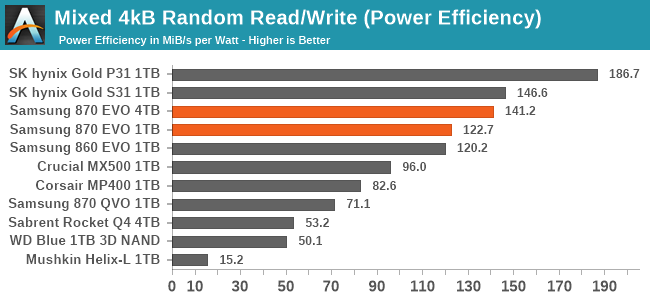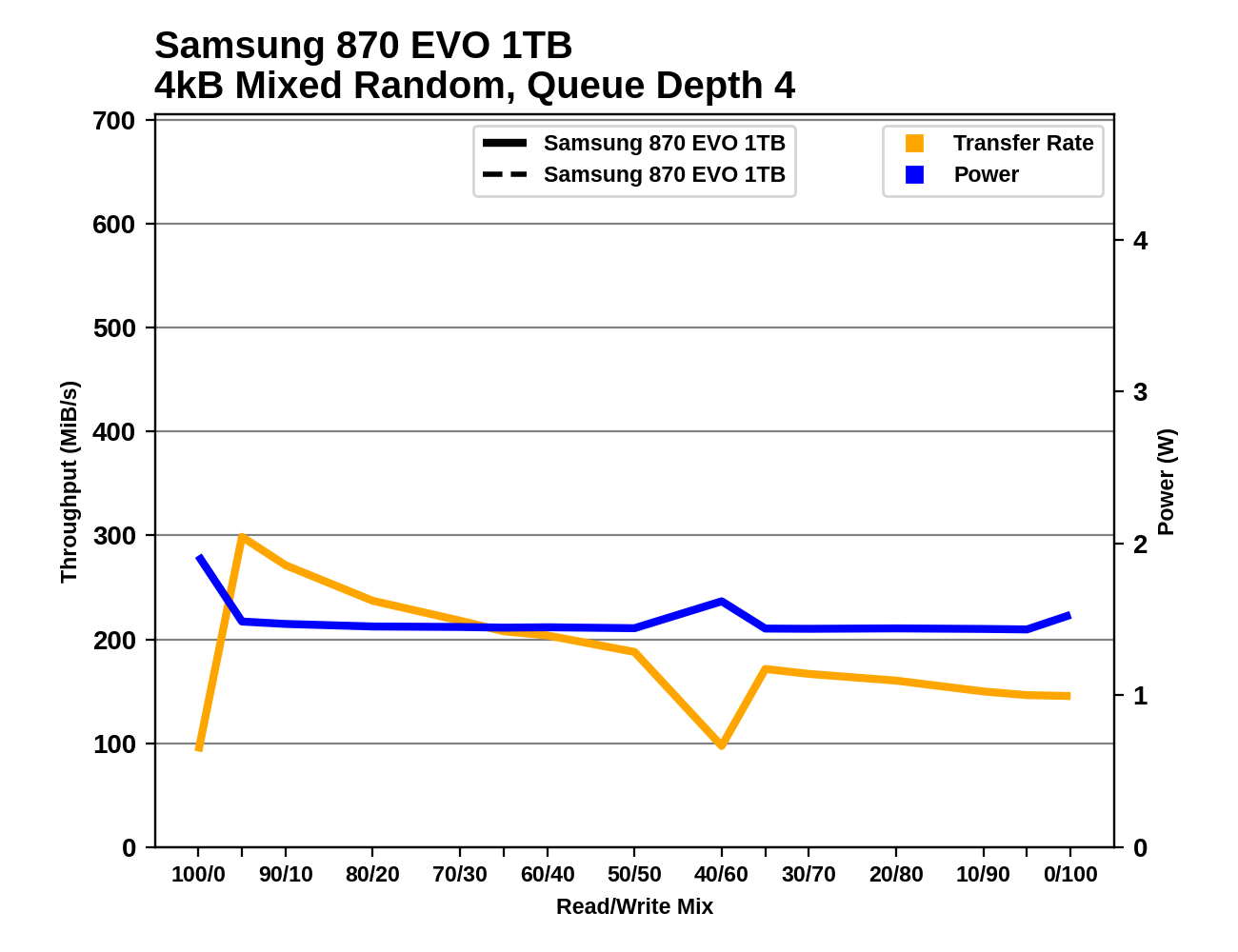The Samsung 870 EVO (1TB & 4TB) Review: Does the World Need Premium SATA SSDs?
by Billy Tallis on February 17, 2021 8:00 AM ESTMixed IO Performance
For details on our mixed IO tests, please see the overview of our 2021 Consumer SSD Benchmark Suite.
 |
|||||||||
| Mixed Random IO | Mixed Sequential IO | ||||||||
The mixed random IO test provides the Samsung 870 EVO with one of its biggest performance wins yet over the rest of the SATA field and the entry-level NVMe competition. But most of that comes from the capacity advantage the 4TB model has over most of these comparison drives; the 1TB 870 EVO is only about 5% faster overall than the 860 EVO. On the mixed sequential IO test, the SATA bottleneck keeps most of the performance scores within a fairly narrow range, and the 1TB 870 EVO's performance is actually a bit of a regression compared to its predecessor.
 |
|||||||||
| Mixed Random IO | Mixed Sequential IO | ||||||||
As with our separate tests of random reads and writes, the top efficiency scores for mixed random IO go to SK hynix, with Samsung's TLC drives turning in the next best scores and having a clear advantage over other competing brands. Over on the sequential IO side of things, the efficiency scores more closely mirror the performance scores, and the 870 EVO doesn't have any real advantage over other mainstream SATA drives.
 |
|||||||||
| Mixed Random IO | |||||||||
| Mixed Sequential IO | |||||||||
The 1TB 870 EVO's performance during the mixed random IO test is more consistent than the 860 EVO's, but still has a few unpleasant drops that aren't present for the 4TB model. On the mixed sequential IO test, the 1TB 870 EVO's performance is actually a bit less consistent than the 860 EVO. But aside from those occasional outliers, the general trend is for the 870 EVO to provide superior random IO performance and link-saturating sequential performance across a wide range of workload mixes.
Idle Power Management
Real-world client storage workloads leave SSDs idle most of the time, so the active power measurements presented earlier in this review only account for a small part of what determines a drive's suitability for battery-powered use. Especially under light use, the power efficiency of a SSD is determined mostly be how well it can save power when idle.
SATA SSDs are tested with SATA link power management disabled to measure their active idle power draw, and with it enabled for the deeper idle power consumption score and the idle wake-up latency test. Our testbed, like any ordinary desktop system, cannot trigger the deepest DevSleep idle state. For more details, please see the overview of our 2021 Consumer SSD Benchmark Suite.


The Samsung 870 EVO may feature an updated controller compared to the 860 EVO, but there's no real difference in idle power consumption, for either active idle or the desktop (non-DevSleep) idle states. Samsung's idle power figures are best in class, with SK hynix offering the only close competition.

The Samsung SATA drives all take about one millisecond to wake up from using SATA link power management. This is higher than several of the other SATA drives, but not really enough to be of much concern for system responsiveness.










136 Comments
View All Comments
Billy Tallis - Thursday, February 18, 2021 - link
I still occasionally use SATA SSDs as if they were floppies, since all of my desktops have hot-swap bays. But its becoming more common that I use M.2 NVMe SSDs in USB enclosures. Either solution is preferable to WiFi or gigE when transferring tens of GB or more.Kamen Rider Blade - Thursday, February 18, 2021 - link
Not every machine is going to be connected locally on your own network.Not every machine will even be online either.
Please don't comment for the rest of us.
Spunjji - Friday, February 19, 2021 - link
M.2 in a USB 3.2 / Thunderbolt caddySorted
CaptainChaos - Wednesday, February 17, 2021 - link
How many grannies or grandpas need more than what SATA offers in the machines they use to go online for email, Facebook, or Amazon? Even if they stream videos their systems are ok using hardware a couple steps behind state of the art! SATA will linger for several more years.Oxford Guy - Friday, February 19, 2021 - link
640K ought to be enough for anyone.lmcd - Wednesday, February 17, 2021 - link
The thing that gets me is that just because a drive is U.2 doesn't mean it has to be a full 2.5in drive. Could easily do a "half size" or some random thing.Silver5urfer - Wednesday, February 17, 2021 - link
Yes the world needs a SATA SSD lol.NVMe drives are tooo damn hot. I don't know how long they will run like that, I've been running SATA without any ventilation on my notebook machine and use MLC drive for games and it's fantastic. Reliable doesn't overheat or has BS driver things esp for Win7 or such.
I thank Samsung for at-least doing this, I hope they put out a damn MLC with 4TB as well and do an 8TB 870 EVO update. As for SATA it's a reliable technology and has numerous advantages over the stupid PCIe lane limit, bandwidth, heat, dependable TBW.
lmcd - Wednesday, February 17, 2021 - link
There's a reason people are going wild over the SK Hynix P31. It's exactly what you need.Danvelopment - Wednesday, February 17, 2021 - link
SATA drives totally still make sense.Why?
Because there's only so much space on a motherboard, and every m.2 drive takes up quite a bit of it.
SATA allows you to redistribute drives within the case.
Maybe once hard drives are gone, then a new form factor can come out, 1" SATA or something. But cases will still be made with HDD form factors until they disappear, so might as well stick to that standard.
But they should do something about IOPS, design a drive destined to be SATA, with a controller that can knock out the full 600MBps with any load pattern, dump three or four times as many channels on it as an m.2, and they'll fly off the shelves.
Gigaplex - Wednesday, February 17, 2021 - link
Then you should be using U.2 instead of M.2.